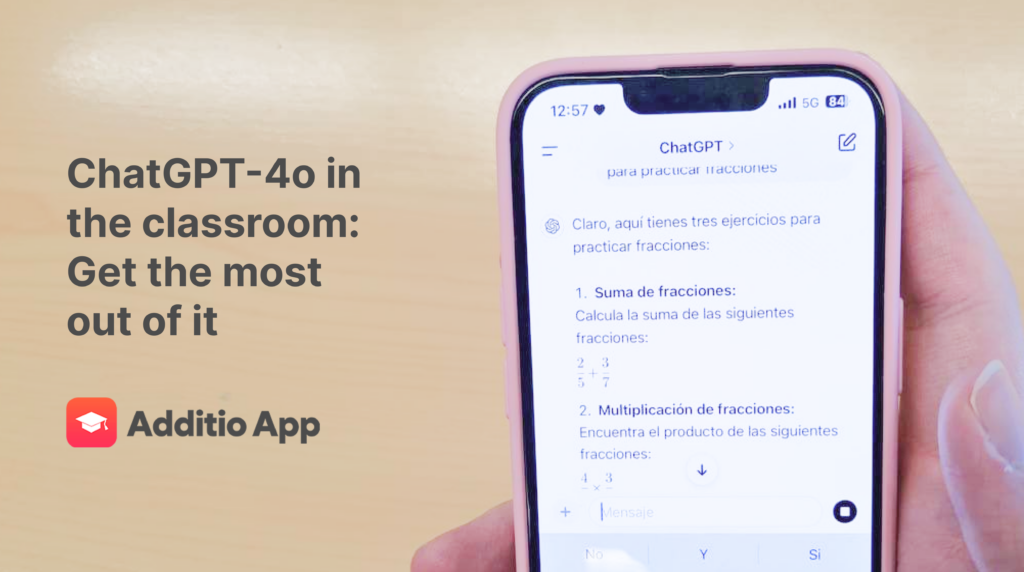There is no doubt that artificial intelligence is here to stay. In recent years, AI-based tools have done nothing but grow and update, and are now an indispensable tool for many.
The educational field is no less. If a responsible and ethical use of artificial intelligence tools is made, it can lead to significant savings in resources and time, which can improve the efficiency of teaching. In this post, we will explain the key aspects that you should take into account when developing a successful AI plan for educational centers.
If you are interested in everything related to AI, don’t miss other posts about AI in education, educational prompts for the classroom or tips for using ChatGPT-4o.
From AI to EHI
A few months ago, in Additio App we held a Tech Breakfast, a meeting with educational centers of reference in Madrid, where we had the opportunity to have the presentation of José Luis Hernández, Digitalization advisor at the University Carlos III of Madrid and expert in AI. In this presentation, he highlighted the step to be made from AI to HAI, that is, from Artificial Intelligence to Extended Human Intelligence.
The concept of Extended Human Intelligence (EHI) is based on the premise that AI should not be seen as a competition, a danger or a substitute for human capabilities, but as an ally that enhances our capabilities and helps us to be more creative and efficient.
Therefore, AI complements human intelligence, and it is we who bring ethics, meaning and purpose to everything generated by artificial intelligence.
Step 1 to create an AI plan for schools: analysis of the current situation
Before venturing to implement the use of artificial intelligence in the school and classroom, it will be important to analyze the current situation of the school.
What does this mean? That we cannot start the house from the roof, and that before creating any AI plan in educational centers, we must know exactly what use is currently being made of it, with what tools, and what improvements can be applied.
The key elements to determine in this situation analysis are as follows:
- What use is being made at the academic management level of AI currently?
- What use are teachers currently making of AI?
- What use are students currently making of AI?
- What tools are currently being used?
- How knowledgeable are the users about each of these tools?
- What training do they have about these tools, and what training would they need to use them responsibly?
- What needs does the center have that could be met with the use of AI tools?
- What tools on the market would be really useful to help in academic management, teaching and learning?
Step 2: Definition of objectives
Once the situation analysis is done, the next step to create an IA plan in educational centers is to define the objectives of this plan.
The objectives have to be defined in this way:
- They must be clear and concise, so that there is no room for doubt!
- They must be measurable, i.e., include indicators that make it possible to evaluate their level of fulfillment.
- They must be achievable, taking into account the resources available, the time available, and the budget available.
- They must be aligned with the center’s educational project, responding to the center’s real needs.
- Clear deadlines should be established to meet the objectives, which will help to prioritize tasks.
Some examples of objectives that you can set are the following:
- “Incorporate an AI tool to personalize the learning process in secondary mathematics during the school year.”
- “Train 80% of the teaching staff in the use of AI tools before the end of the school year”.
- “Integrate AI tools to create content and foster the inclusion of students with special educational needs.”
- “Design an Action and Supervision Protocol document to serve as a reference for all teaching and administration staff at the educational center.”
Step 3: Defining the pyramid framework for AI adoption in the school
A key step to build a good AI plan in schools is to establish the pyramidal framework for AI adoption. This is what José Luis Hernández talked about in his presentation at our Tech Breakfast, so take note!
According to José Luis Hernández, artificial intelligence can be integrated in a practical way in three key areas: academic management, teaching and learning. Therefore, we are talking about the school’s management and administrative team, teachers and students. This pyramidal framework is adaptable to the needs of each educational center, but serves as a solid basis for moving forward.
- Pyramid 1: AI in school management.
In this pyramid, educational institutions implement artificial intelligence solutions to improve their academic management.
This means, for example, reducing manual workload, or improving efficiency in their processes. It may also involve using AI to generate intelligent reports for more informed decision-making that puts the learner at the center of learning.
- Pyramid 2: AI in teaching.
In this pyramid, it is established that the use of AI for teaching is of great use in improving the effectiveness of teaching, provided that it is used correctly and responsibly.
Among other things, in this pyramid we talk about adapting content to the specific educational needs that students have, without placing an extra workload on teachers. This helps to foster more meaningful student learning.
We also talk here about creating content to improve the effectiveness of teachers’ pedagogical practices. AI becomes an ally to create content and materials aligned with the purposes and objectives of teachers, offering innovative visions that allow improving teaching practice, always with the academic progress of students in mind.
- Pyramid 3: AI in learning.
Finally, pyramid 3 focuses on the role of AI in student learning. It also involves a process of reflection on how students can make a conscious and responsible use of advanced technology, such as AI, because although it offers a lot of help, it is not without its dangers.
This pyramid also focuses on how the use of AI can improve students’ understanding of concepts and motivation, and how the implementation of AI improves students’ technical skills.
Step 4: Selection of tools to be implemented
Once the pyramidal framework and the objectives of the IA plan in our center have been defined, the next step is to select the tools to be implemented in the school. This phase is crucial, as the right choice can make the difference between success and failure of the plan.
Key aspects to consider when choosing the right tools:
- Relevance: The tools must be aligned with the objectives set and respond to specific needs of the center.
- Usability: It is essential that the tools are intuitive and easy to use for teachers, students and administrative staff.
- Compatibility: Verify that the tools chosen integrate well with the center’s existing systems, such as academic management platforms.
- Cost and sustainability: Evaluate the available budget and the cost of the tool.
- Ethics and security: Ensure that the tools comply with data protection regulations and promote responsible use of AI.
Examples of tools:
- For academic management: AI systems that automate enrollment, schedules or customized reports. For example, our AI-based timetable generator allows the creation of school timetables in a few minutes, taking into account all kinds of casuistry.
- For teaching: Platforms that generate content adapted to the needs of students. For example, if you use good prompts in ChatGPT, the results can be impressive.
- For learning: Applications that encourage guided practice and personalization of the study pace. If you want to start training your learners in the responsible use of AI, before jumping into using your own study tools, try Teachable Machine.
- Looking for more tools? We tell you more in this post.
Step 5: Training for teachers and administration staff
Training is one of the fundamental pillars to ensure the successful implementation of AI in the school. Without a trained team, efficient use of the various tools will not be achieved.
Keys to effective training:
- Tailored to each person’s role: it is important to offer specific training according to each person’s role (teacher, director…). For example, you can train people from the administration team in the use of the Additio App timetable generator.
- Practical: Prioritizes hands-on workshops to experiment directly with the tools.
- Progressive: Offer training levels ranging from basic to advanced, ensuring an adequate learning curve.
- Continuous: It is important to offer periodic training to update knowledge.
Step 6: Development of protocols for action and monitoring
To ensure ethical, safe and efficient use of AI tools, it is essential to establish clear protocols to guide the entire educational community that is part of the center: administrative staff, management team, teachers, students, families…
What should the protocols include?
- Rules of use: Establish guidelines on how, when and for what purpose each AI tool should be used.
- Privacy and data protection: Defines measures to protect sensitive information.
- Ethics: Includes principles to ensure responsible use of AI, avoiding biases or inequalities.
- Oversight: Designates responsible persons to oversee the implementation and use of the tools to ensure that protocols are followed.
A well-prepared document will facilitate daily work and provide confidence to families and students.
Step 7: Continuous evaluation
The implementation of an IA plan should be a dynamic process that is constantly evaluated and adjusted.
How to evaluate the IA plan?
- Define indicators of success: For example, time saved in administrative tasks, improvement in learning outcomes or the degree of satisfaction of administrative staff, teachers or students.
- Periodic reviews: Establish key moments to evaluate progress and detect areas for improvement.
- Feedback from the educational community: Gathers opinions from teachers, students and families on the impact of AI.
- Adoption of improvements: Adjust tools, protocols or training according to the results of the evaluations.
To conclude
With a well-defined strategy, the right tools and ongoing training, artificial intelligence can become a key ally in transforming teaching and learning.
Do you already have an AI plan in your school? We would love to know how it is, tell us about it on our social media: Facebook, Twitter, Instagram and Youtube.
Remember, with Additio App, you can perform competency-based assessments that place students at the center of learning, keeping them informed about their progress and helping them identify areas for improvement and strengths.
Over 150 features support you in enhancing your teaching and your students’ learning experience. Register and take your teaching to the next level!
See you soon!





